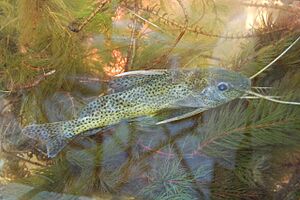Synodontis nigromaculatus facts for kids
Quick facts for kids Synodontis nigromaculatus |
|
|---|---|
 |
|
| Conservation status | |
| Scientific classification | |
| Genus: |
Synodontis
|
| Species: |
nigromaculatus
|
The spotted squeaker (Synodontis nigromaculatus) is a type of upside-down catfish. It's also called the blackspotted squeaker or speckled squeaker. This fish lives in many parts of southern Africa. You can find it in countries like Angola, Botswana, the Democratic Republic of the Congo, Mozambique, Namibia, South Africa, Zambia, and Zimbabwe. A scientist named George Albert Boulenger first described this fish in 1905. He found it near Lake Bangweulu in Zambia.
Contents
What Does the Spotted Squeaker Look Like?
Like other Synodontis fish, the spotted squeaker has a strong, bony head. This head bone goes all the way back to its first fin on its back. Its head also has a special bony part called a humeral process. This part sticks out and helps scientists tell different Synodontis species apart. For the spotted squeaker, this part is long and pointy.
Its Whiskers and Fins
This fish has three pairs of barbels, which are like whiskers. One pair is on its upper jaw. Two pairs are on its lower jaw. The upper whiskers are long and straight. They are about one and a third times the length of its head. The outer lower whiskers are twice as long as the inner ones. Both lower pairs have thin branches.
The front edges of its back fin (dorsal fin) and side fins (pectoral fins) are stiff spines. The spine on its back fin is straight and long. It's about as long as its head. This spine is smooth on the front and rough on the back. The rest of the back fin has seven soft rays. The spine on its side fin is about the same length. It is rough on both sides. The small, fleshy fin near its tail (adipose fin) is four times longer than it is tall. Its bottom fin (anal fin) has four stiff rays and seven soft rays. The tail fin is deeply split, with the top part being longer.
Its Teeth and Body Color
All Synodontis fish have a special pad of teeth on their upper jaw. This pad has rows of short, chisel-shaped teeth. For the spotted squeaker, this tooth pad is short and wide. On its lower jaw, the teeth are S-shaped or hooked. They are attached to flexible stalks. The number of teeth helps identify the species. The spotted squeaker has about 30 teeth on its lower jaw.
The body of the spotted squeaker is grey on top and white underneath. Its body is covered with round black spots. This fish can grow up to 38.5 centimeters (about 15 inches) long. The heaviest one found weighed about 315 grams (11 ounces). Female Synodontis fish are usually a bit bigger than males of the same age.
Where Does the Spotted Squeaker Live and What Does It Do?
The spotted squeaker lives all over southern Africa. In central Africa, it's found in rivers that flow into the Congo River. In eastern Africa, it lives in Lake Tanganyika. In southern Africa, you can find it in the upper Zambezi River and Okavango River systems. It also lives in the Kasai River and Limpopo River systems.
Habitat and Diet
This fish likes to live near rocks or plants. It can be found at the edges of rivers, in lagoons, or in calm backwaters. We don't know much about how most Synodontis species reproduce. We do know that spawning probably happens during the rainy season. This is usually between July and October. During this time, pairs of fish swim together to lay eggs.
The spotted squeaker eats many different things. It feeds on dead plant and animal bits (detritus). It also eats algae and plant matter like seeds. Sometimes it eats small fish. It also enjoys small bugs and snails. These fish grow quickly in their first year. After that, their growth slows down as they get older.


